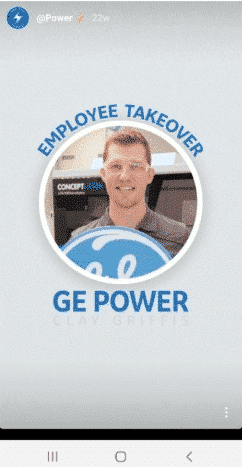Keep reading to explore more of 10 best Instagram practices in 2020.
5. Rock those Instagram Stories
One of those 10 Instagram best practices in 2020 is Instagram Stories. They show photos or short video that appear at the top of their feed for 24 hours. Stories might contain text, links, and even GIFs.
The new Stories Layout feature give users five new layout options with tons of frames. And of course, there are plenty of great Stories apps for iOS and Android.
Put to good use, using Stories is an awesome and powerful engagement technique. With Stories, you can:
- Drive traffic to a new Instagram post or product page
- Use the “Ask me anything” feature to encourage your followers answer questions and share their responses
- Create a poll to make buzz around your new product or brand development
You can also make Story Highlights (which don’t expire) on your profile page. This is a great way to invite visitors to get to know your brand.
Let’s take a look at some examples of how leading brands are using Instagram Stories.
Here, ThredUP is alerting users to some recent clothing finds.
Harry’s is kicking off a Q&A session.
Fender is showing a shout out to its brand community.
GE is taking users behind the scenes.
Instagram provide you with some valuable tips for making the most of Instagram Stories:
- Aim for the unconventional. Experiment with filters and drawing tools as well as video editing tools such as Boomerang (now with SloMo, Echo, and Duo effects) and Hyperlapse.
- Lean into that 24-hour limit. Make an offer or invite so irresistible, people will be afraid to miss out on it.
- Don’t neglect sound. Treat viewers to a multisensory experience.
Not sure how to get started with Instagram Stories? Here’s a step-by-step guide.
6. When setting goals, consider short- and long-term value
Your Instagram posts and campaigns should be designed to appeal to your target audience based on their interests. To drive results over time, you’ll need to set S.M.A.R.T. goals (specific, measurable, attainable, relevant, and timely) and determine how you’ll measure success.
Based on our annual survey of more than 3,000 marketers for our Social Media Trends 2020 report, 44% indicated that “driving conversions” is the #1 aim of their social media efforts.
While this is an important goal that can easily be measured against, conversions are short-term wins. Focusing on building brand equity and delighting existing customers could deliver far more value in the long run.
7. Create a content calendar
Spontaneous posts are fine when opportunity strikes. But steady progress requires marketing discipline. Make use of a content calendar to organize your posts and schedule them in advance.
- Identify themes. They can be seasonal, reflect current events or trends, or play on your target audience’s lifestyle and/or values. Choose themes that show your brand personality and products.
- Choose the right formats. Would Stories, a photo carousel, a video series, or some other posts or ad type best deliver your intended message?
- Don’t wait to write captions. You need to always be ready to post, even when your publishing schedule gets thrown.
- Pay attention to timing. Schedule posts based on how much time you’ll need for content creation and the most appropriate time(s) to publish.
- Establish workflows. Carve out a dedicated block of Instagram time, or determine a daily post quantity—whatever suits your team and business interests.
8. Expand your reach with hashtags and geotags
Instagram users search for content using hashtags (#). They can also follow hashtags.
By including relevant hashtags in your bio and your post captions, you’re exposing a lot of potential new followers to your brand and products.
If you’re a brick-and-mortar business trying to reach users in your area, using geotags can help you make those local connections.
9. Use Insights to track engagement and conversions
Your Insights page, which you can access through your profile, gives a detailed view of how your content is performing. Insights for Stories are available for up to 14 days after Stories appear.
- Content: This tab reveals your brand’s most popular posts (as measured by total impressions). You can also see data for individual posts including total impressions and users engaged.
- Activity: Here, you’ll find profile visits, website clicks, and information about where and how users are finding your content.
- Audience – This tab offers metrics about your followers (if you have at least 100). You’ll know their gender, age, and location; when they’re most active on Instagram; and how fast your brand community is growing.
As the insights begin to flow, pay attention to trends and look for outlier posts. Both high and low performers can help you fine-tune your messaging and design. You can even cannibalize winning posts for future content or turn them into paid ads to maximize your ROI on the platform.
10. Turn awesome organic posts into marketing gold
In case an organic post is seeing heavy engagement, it could be worth promoting. To get started, just follow these simple steps:
- Click the “promote” button below the post.
- Choose a business objective and a call to action (“Learn More,” “Watch More,” “Shop Now,” “Book Now,” “Sign Up,” or “Contact Us”).
- Find your audience (let Instagram do it, or create your own).
- Select a budget and campaign duration (you’ll see estimated reach next to your entries).
- Review your order, including method of pay.
- Right when your promotion is approved, Insights will appear in your notifications tab.
Branded content, a relatively new Instagram feature, allows you to partner with individual creators of organic branded content (even Facebook content) and promote their posts as Instagram feed or Stories ads.
Which one in these 10 best Instagram practices above do you choose to make a splash, grow your reach, and maximize your resources in 2020?





